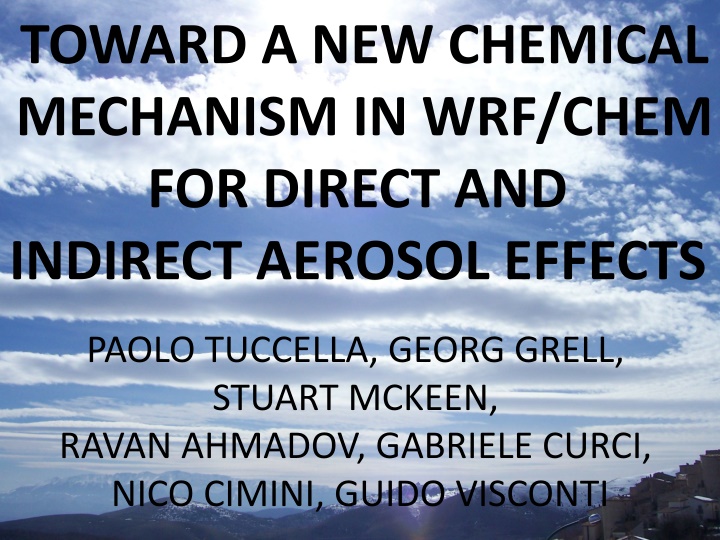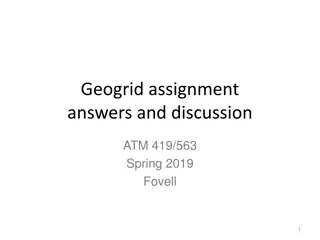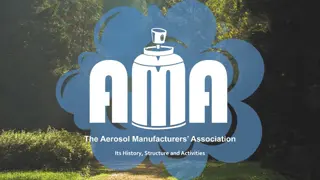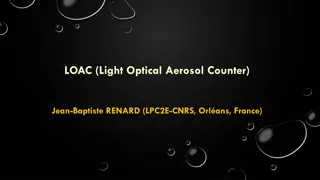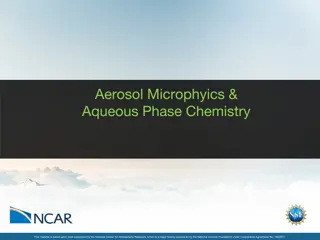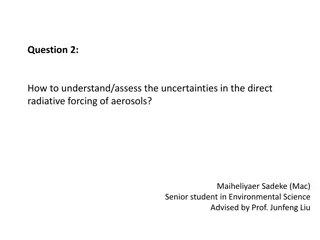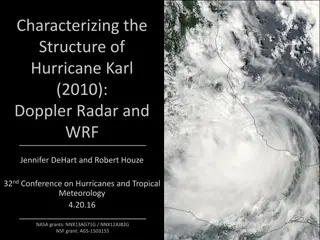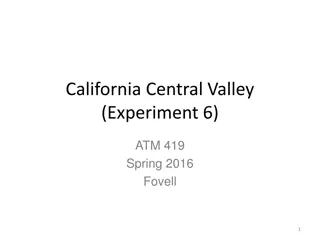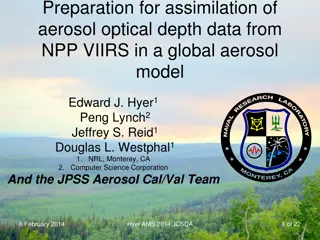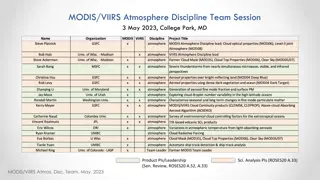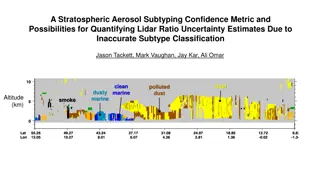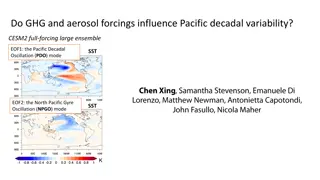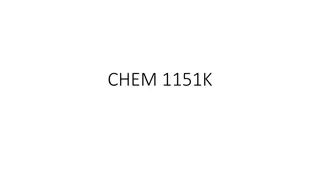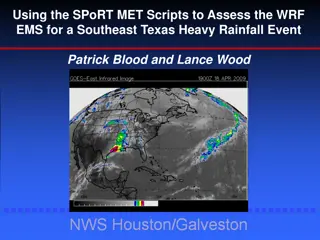Advancements in Chemical Mechanisms for Aerosol Effects in WRF/Chem Model
This study focuses on the development of a new chemical mechanism in the Weather Research and Forecasting with Chemistry (WRF/Chem) model to address the underestimation of carbonaceous aerosols. The RACM/MADE/SOA-VBS mechanism incorporates advancements in gas-phase chemistry and particle parameterization to better simulate secondary organic aerosols (SOA) from both anthropogenic and biogenic sources. The WRF/Chem setup includes detailed physical processes and emission data comparisons with observed values. Despite some underestimations, this new mechanism shows promising results for improving the representation of aerosol composition in atmospheric models.
Download Presentation

Please find below an Image/Link to download the presentation.
The content on the website is provided AS IS for your information and personal use only. It may not be sold, licensed, or shared on other websites without obtaining consent from the author.If you encounter any issues during the download, it is possible that the publisher has removed the file from their server.
You are allowed to download the files provided on this website for personal or commercial use, subject to the condition that they are used lawfully. All files are the property of their respective owners.
The content on the website is provided AS IS for your information and personal use only. It may not be sold, licensed, or shared on other websites without obtaining consent from the author.
E N D
Presentation Transcript
TOWARD A NEW CHEMICAL MECHANISM IN WRF/CHEM FOR DIRECT AND INDIRECT AEROSOL EFFECTS PAOLO TUCCELLA, GEORG GRELL, STUART MCKEEN, RAVAN AHMADOV, GABRIELE CURCI, NICO CIMINI, GUIDO VISCONTI
WHY A NEW CHEMICAL MECHANISM? A FOCUS ON THE CARBONACEUS AEROSOLS PM2.5 is underestimated by a factor 2 using the classic configuration (MADE/SORGAM aerosol mechanism) The underestimation is due to the carbonaceous aerosols. Organic matter (-76%) [Tuccella et al., JGR, 2012]
THE RACM/MADE/SOA-VBS MECHANISM 1)The gas phase chemistry is simulated with the Ragional Atmospheric Chemistry Model (RACM) updated to include the sesquiterpenes. 2)Particle parameterization: MADE. 3)The production of SOA is based on the Volatile Basis Set approch. 4)The new scheme contains 4 volatile bins for each SOA class (16 SOA and 8 OCVs). 5)The SOAs are formed by anthropogenic and biogenic sources. [Ahmadov et al., JGR, 2012]
WRF/CHEM SETUP Period: May-June 2003. Resolution: 30 Km, 28 vertical levels (p_top = 50 hPa, 15-16 Km). Initial and boundary meteorological conditions: NCEP analysis (every 6 hours). Initial and boundary chemical conditions: climatological profiles. PHYSICAL PROCESS WRF/CHEM OPTION MICROPHYSIC MORRISON Anthropogenic Emissions: LONGWAWE RRTM SHORTWAWE GODDARD EMEP and Laboratoire d Aerologie for OC/EC SURFACE LAYER MONIN-OBUKHOV LAND SURFACE NOAH LSM PBL MYNN LEVEL 2.5 PBL CUMULUS CLOUDS G3 PHOTOLYSIS MADRONICH BIOGENIC EMISSIONS MEGAN WET DEPOSITION INCLUDED FEEDBACK NO
WRF/CHEM vs EC/OC EMEP DATA (2002-2003 CAMPAIGN) Daily sample/week Obeservd OA = 1.6 OC EC: r=0.64 bias=-17% OA: r=0.70 bias=-38%
WRF/CHEM vs EC/OC EMEP DATA: OA:EC RATIO OBSERVED MODELED WRF/Chem underestimates the observed correlation and slope of OA:EC ratio
DIURNAL VARIATION OF MODELED OA COMPOSITION AT EMEP STATIONS Modeled OA composition is nearly constant during all the day. Simulated SOA/OA: 80%, at the upper end of the 50-80% observed [Jiminez et al., Science, 2009] Simulated BSOA/SOA: 30% (50-60% in South Europe)
PM2.5: WRF/Chem vs EMEP (10-19 May 2003) NO WITH FEEDBACK FEEDBACK r=0.34 r=0.43 With direct and indirect aerosol feedback, the simulation of PM2.5 improves. SORGAM WITH FEEDBACK r=0.20
AOT@400 nm: WRF/Chem vs MODIS (11/05/2003) MODIS SORGAM with FEEDBACK NEW SOA with FEEDBACK New SOA parameterization is able to capture the variability of AOT
COT: WRF/Chem vs MODIS (16/05/2003) MODIS NO FEEDBACK SORGAM with FEEDBACK NEW SOA with FEEDBACK
CONCLUSIONS A new scheme for production of SOA implemented in WRF/chem has been evaluated over Europe. The carbonaceous aerosols are underestimated. The new scheme has been coupled with the radiation and microphysics sheme to include the direct and indirect aerosols effects. Preliminary tests on aerosol radiation-cloud feedback reveal a significant sensitivity of the model to indirect effects. When they are included, the simulations of the PM2.5 mass, aerosol optical depth and cloud optical depth improves.
ANTHROPOGENIC EMISSIONS 1. Total annual emissions from EMEP: CO, NH3, SO2, NOx, VOC, PM 2. Correspondence among emitted and model species CO CO NOx NOx PM 20% PM fine, 80% PM coarse 3. Speciation of VOCs [Passant, 2002] AGGREGATION VOC1 IN 17 WRF/CHEM MODEL SPECIES WITH REACTIVITY WEIGHTING FACTOR PRINCIPLE [Middleton et al., Atmo. Env. 1990] VOC2 VOC VOC350
